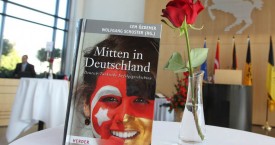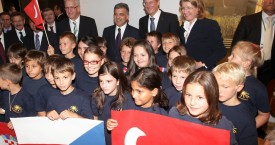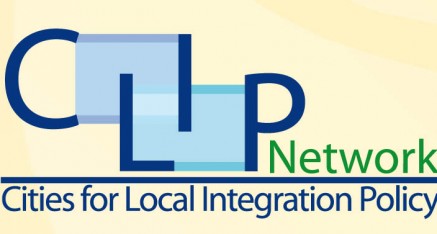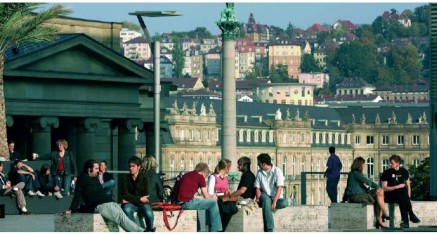Je internationaler eine Stadt ist dank Bildung, Wissenschaft und Forschung, Unternehmen und kultureller Vielfalt, je attraktiver ist sie für Menschen aus aller Welt. Je attraktiver eine Stadt ist, je internationaler ist die Stadt mit ihren Bürgern, Unternehmen, Wissenschafts- und Forschungseinrichtungen und kulturellen Leben.
Diesen dialektischen Prozess lässt sich in New York, San Francisco, Toronto ebenso beobachten wie in Hamburg, München, Frankfurt oder Stuttgart. Alle diese Städte sind in nationalen und internationalen Qualitäts-Rankings ganz vorne und haben zugleich die höchsten Anteile von Migranten. Deshalb war es auch nicht verwunderlich dass 2015 und 2016 die Flüchtlinge vor allem aus Syrien nach Deutschland wollten. Dies zumal in Deutschland viele Arbeitsplätze nicht besetzt sind und wir an einem wachsenden Facharbeitermangel leiden. Die so genannte Flüchtlingskrise konnte nicht zuletzt durch das großartige ehrenamtliche Engagement von tausenden von Bürgern bewältigt werden. Die mangelhaften Grenzkontrollen haben gleichzeitig bei vielen Mitbürgern das Gefühl erzeugt, dass der Staat nicht mehr die Sicherheit in ausreichendem Umfang gewährleisten kann.
Gesetzesänderungen zum Asylrecht und zur Einwanderung von Fachkräften sollen in Zukunft auf deutscher und europäischer Ebene dafür sorgen, das Asylrecht für Flüchtlinge und die Zuwanderung von Fachkräften klarer und besser geregelt sind.
Unabhängig davon gilt es vor Ort die Menschen zu integrieren, die zu uns gekommen sind. Diese Aufgabe ist nicht nur aus menschlichen und sozialen Gründen sinnvoll, sondern auch aus finanziellen und Arbeitsmarkt-Gründen. Keine Stadt in Deutschland kommt ohne zugewanderte Mitarbeiter aus, die häufig schwere und unangenehme Aufgaben im öffentlichen wie im privaten Sektor wahrnehmen.
Rund 40 % der Stuttgarter haben einen Migrationshintergrund, bei unseren Kindern sind es inzwischen rund 60%. Diese Einwanderer gilt es in unserer Stadtgesellschaft zu integrieren, damit sie eine neue Heimat in Stuttgart finden können. Dies war die Ausgangsüberlegung für das Stuttgarter Bündnis für Integration im Jahr 2000.
Konzeption
Die Landeshauptstadt Stuttgart hat im Jahre 2001 mit dem Bündnis für Integration als erste deutsche Großstadt ein Konzept zur kommunalen Integrationspolitik im Sinne einer Gesamtstrategie entwickelt. Das Stuttgarter Bündnis für Integration bildete in den Folgejahren eine wichtige Grundlage bei der Entwicklung vergleichbarer Integrationskonzepte in anderen deutschen Städten. Von Stuttgart gingen ebenso Impulse bei der Erstellung des Nationalen Integrationsplans der Bundesregierung und der Integrationspläne einiger Länder aus. Das Bündnis für Integration diente als Modell für die integrationspolitischen Handlungsempfehlungen des Europarates für die Mitgliedsstädte des Kongresses der Gemeinden und Regionen Europas. Im Jahr 2006 haben wir in enger Zusammenarbeit mit europäischen Institutionen das Städtenetzwerk „Cities for Local Integration Policies for Migrants“ (CLIP) initiiert. Seitdem stehen wir in einem regelmäßigen Erfahrungsaustausch mit 30 europäischen Städten und mit europäischen Forschungsinstituten zu Migrationsstudien.
Bei der Neuausrichtung der Stuttgarter Integrationspolitik im Jahr 2001 war unsere Grundüberlegung: Stuttgart ist eine Einwanderungsstadt und jeder, der hier lebt, ist Stuttgarter Bürger.
Unter gelungener Integration verstehen wir die gleichberechtigte Teilhabe der „neuen Stuttgarterinnen und Stuttgarter“ mit Migrationshintergrund am gesellschaftlichen Leben in der Stadt. Aktive Partizipation ist die Basis für die Integration und für die Identifikation der Einwanderer mit ihrer Stadt. Stuttgart hat in den vergangenen Jahrzehnten in allen Bereichen von der Zuwanderung profitiert. Migranten sind ein Motor für die Stadtentwicklung. Damit ihre Potenziale – Innovation, Kreativität und Unternehmergeist – für die Gesellschaft als Ganzes nutzbar gemacht werden können, bedarf es seitens der Aufnahmegesellschaft einer Willkommenskultur, einer Politik der Anerkennung der kulturellen Vielfalt, verbunden mit Strategien zur Förderung der Potenziale und Kompetenzen der Einwanderer als der „neuen Stuttgarter“. Im Hinblick auf Standortentscheidungen werden Städte zunehmend auch aufgrund ihres internationalen Flairs, ihrer Innovationsbereitschaft und ihrer Offenheit gegenüber modernen interkulturellen Lebensformen beurteilt. Die Landeshauptstadt Stuttgart und die Region Stuttgart sind unter den Top 10 der Hightech-Standorte in Europa. Als exportstärkste Region in Deutschland stehen wir im internationalen Wettbewerb mit anderen Wirtschaftsstandorten in Europa und der Welt.
– Leitziele –
Bereits 2001 haben wir für die Integrationspolitik folgende Leitziele abgeleitet, die nach wie vor ihre Gültigkeit haben:
1. Die Förderung der Partizipation und der Chancengleichheit von Menschen unterschiedlicher Herkunft. Dies beinhaltet sowohl die gesellschaftliche und politische Partizipation in Übereinstimmung mit den gesetzlichen
Möglichkeiten als auch Chancengleichheit in den zentralen Bereichen des gesellschaftlichen Lebens: Sprachliche Verständigung, Schulbildung und berufliche Qualifizierung, Erwerbstätigkeit, Wohnsituation, Inanspruchnahme der kommunalen Serviceleistungen, selbst organisierte Aktivitäten in Vereinen und Religionsgemeinschaften.
2. Die Förderung des friedlichen Zusammenlebens der verschiedenen Bevölkerungsgruppen. Unser Integrationskonzept sieht auch die Einbeziehung der Aufnahme beziehungsweise Mehrheitsgesellschaft als einen zentralen und integralen Bestandteil von Integrationspolitik vor. Dabei werden zwei Zielvorgaben miteinander verknüpft: die Bewusstmachung der Prämisse „eine Stadtgemeinschaft – viele Lebenswelten“ als positive gesellschaftliche Realität und die konsequente Verfolgung und Bestrafung von fremdenfeindlichen Handlungen.
3. Die Nutzung der kulturellen Vielfalt für die Erweiterung der persönlichen und beruflichen Kompetenzen aller in der internationalen Stadtgesellschaft. Sprachlicher Reichtum ist dabei ein wesentlicher Faktor. Diesen Reichtum wollen wir bewusst mehren und offensiv als Teil einer „Exportstrategie verkaufen“.
– Handlungsfelder –
Diese Leitziele werden in den 15 integrationspolitische Handlungsfelder konkretisiert und systematisch durch integrationsfördernde Strategien und Maßnahmen umgesetzt:
1. Integration durch Bildung
2. Berufliche Integration
3. Soziale Integration
4. Integration vor Ort
5. Integration durch bürgerschaftliches Engagement
6. Politische Partizipation
7. Interreligiöser Dialog und Integrationsarbeit in den Religionsgemeinschaften
8. Internationalität als Motor für Wirtschaft und Wissenschaft
9. Internationalität und kulturelle Vielfalt
10. Integration durch Sport
11. Sicherheit in unserer internationalen Stadt
12. Interkulturelle Ausrichtung der Stadtverwaltung und ihrer Bündnispartner für Integration
13. Zusammenarbeit der Städte bei Migration und Integration
14. Die Stuttgarter Partnerschaft Eine Welt
15. Öffentlichkeitsarbeit und Medien
Das Stuttgarter Bündnis für Integration wird im Sinne dieser Ziele von allen daran beteiligten gesellschaftlichen Gruppen als eine gemeinsame Aufgabe mitgetragen und umgesetzt: Dazu zählen neben zahlreichen hauptamtlichen Akteuren vor allem Bürgerinnen und Bürger mit und ohne deutschen Pass sowie ihre Vereine. Kurz: Integration ist ohne Bürgerengagement nicht möglich. Einheimische wie Zugewanderte werden im Rahmen des freiwilligen Engagements an der aktiven Mitgestaltung des Gemeinwesens beteiligt. In den letzten Jahren ist es erfreulicherweise gelungen, kompetente Personen mit Zuwanderungshintergrund und zahlreiche Migrantenorganisationen in die Integrationsarbeit einzubinden. Sport-, Kultur- und Bürgervereine sowie Jugendverbände im Stadtjugendring haben sich für Migranten geöffnet und übernehmen verstärkt Verantwortung in der Integrationsarbeit.
Gelingende Integrationsarbeit vor Ort ist somit nicht nur von den dafür eingesetzten finanziellen Ressourcen abhängig. Es bedarf gut organisierter Verantwortungspartnerschaften auf kommunaler Ebene, wie wir sie zum Beispiel mit der Stuttgarter Bildungspartnerschaft und den „Stuttgarter Netzen für alle Kinder“ auf den Weg gebracht haben. Die Verbindungspunkte in diesen tragenden Netzen sind engagierte Menschen, denen unser Dank gilt.
Europäisches Netzwerk „Cities for Local Integration Policies for Mirgrants“ (CLIP)
Die Landeshauptstadt Stuttgart, der Kongress der Gemeinden und Regionen des Europarats (KGRE) sowie die Europäische Stiftung zur Verbesserung der Lebens- und Arbeitsbedingungen mit Sitz in Dublin (Eurofound) haben am 2. Mai 2006 in Stuttgart das europäische Städtenetzwerk „Cities for Local Integration Policy of Migrants“ (CLIP) ins Leben gerufen, um den gemeinsamen Erfahrungsaustausch über erfolgreiche Integrationsstrategien auf europäischer Ebene voranzubringen. Das Netzwerk verfolgt im Wesentlichen die folgenden Ziele:
1. Den derzeitigen Stand der kommunalen Integrationsarbeit länderübergreifend ermitteln und in einer Form dokumentieren, die ein kontinuierliches Monitoring ermöglicht: Vergleich von Lebenslagen der Einwohner mit und ohne Migrationshintergrund in zentralen Handlungsfeldern kommunaler Integrationspolitik wie Wohnen, Bürgerservice der Stadtverwaltung in der kulturell pluralen Stadtgesellschaft (Diversity), interkultureller und interreligiöser Dialog, Beschäftigung, gesellschaftliche und politische Partizipation. Dies erfolgt durch wissenschaftliche Untersuchungen („Fallstudien“) in den Mitgliedsstädten von CLIP, die von externen Experten durchgeführt werden.
2. Den Erfahrungsaustausch über best practice-Beispiele im Sinne des gegenseitigen Lernens über einen längeren Zeitraum sicherstellen und für alle Kommunen abrufbar dokumentieren, um die eigene Integrationsarbeit vor Ort kontinuierlich weiterzuentwickeln.
3. Auf politischer Ebene praxiserprobte und wissenschaftlich fundierte Ergebnisse in Form von Empfehlungen an die nationalen und europäischen Entscheidungsträger in der EU-Kommission und im Europäischen Parlament in deren Arbeit und Entscheidungen einzubringen. Dazu gehört auch die Einbindung des Europarats.
Das CLIP-Netzwerk besteht derzeit aus etwa 35 Städten aus 22 Mitgliedsstaaten des Europarats und 6 Universitäten. Die Mitgliederzahl ist begrenzt, um eine Kontinuität und Arbeitsfähigkeit sicherzustellen. Den „Motor“ von CLIP bilden große und mittlere Einwanderungsstädte aus EU-Ländern mit ausgewiesenen Erfahrungen in der Integrationspolitik, aber auch kleinere Städte sowie Städte mit besonderem Entwicklungsbedarf außerhalb der EU-Grenzen wie die Städte Izmir und Zagreb.
Europäisches Bündnis für Integration
Für eine Willkommenskultur in der Europäischen Union
Derzeit leben mehr als 40 Millionen Ausländer in der Europäischen Union. Damit ändert sich auch die Zusammensetzung der städtischen Bevölkerung ganz wesentlich. Besonders die urbanen Gesellschaften werden immer internationaler und kulturell vielfältiger. Durch den dynamischen Prozess der Globalisierung, die Mobilität der Arbeitnehmer und den demografischen Wandel wird dieser Prozess beschleunigt. Auch künftig werden unterschiedliche Migrantengruppen zuwandern und sich in europäischen Städten niederlassen. Es ist eine Herausforderung, aber zugleich auch eine Chance für uns, neue Zuwanderergruppen zu gewinnen und einen gemeinsamen Integrationsprozess in unserer Gesellschaft zu gewährleisten. Für viele Zuwanderer ist es heute noch schwierig, volle Teilhaberechte am wirtschaftlichen, kulturellen, sozialen und politischen Leben in unserer Gesellschaft zu erlangen. Sie stehen Hindernissen gegenüber, wenn es um gleiche Chancen für eine Beteiligung am sozialen und kulturellen Leben geht.
Ein Blick auf die politische Landkarte Europas zeigt, dass die Integrationspolitiken der Mitgliedsstaaten einem bunten Flickenteppich gleichen, dies sowohl im Hinblick auf die rechtliche wie die wirkliche Situation. Um diese Situation zu ändern, brauchen wir für die Integrationspolitik einen Ansatz, der auf alle Ebenen und alle Arbeitsfelder zielt. Für eine erfolgreiche Integration sind neue Methoden der Zusammenarbeit, neue Anstrengungen vieler Akteure auf den verschiedenen Regierungsebenen in Zusammenarbeit mit dem privaten Sektor und der Bürgergesellschaft erforderlich. Damit Integration gelingt, muss ein gemeinsames Verständnis für die Integrationsaufgabe als Grundlage für eine umfassende EU-Strategie entwickelt werden. Da die rechtlichen Kompetenzen auf den verschiedenen Handlungsfeldern einer ganzheitlichen Integrationspolitik aufgesplittet sind, können wir vernünftige Ergebnisse nur erzielen, wenn wir Kompetenzen, Aufgaben und Vorteile mit den verschiedenen Akteuren teilen – durch ein Regieren in Partnerschaft. Regieren in Partnerschaft beruht auf drei Grundsätzen: Aufgabenteilung, Partnerschaftliches Miteinander und Partizipation
– Aufgaben des Europäischen Bündnisses für Integration –
• Förderung der Chancengleichheit als gemeinsame Aufgabe aller Politikebenen und der Bürgergesellschaft durch Verbesserung des Zugangs zu Bildung, Arbeitsmarkt und öffentlichen Diensten, um alle Talente unserer Bürgerinnen und Bürger zu entfalten und zu nutzen.
• Verbesserung unserer globalen Wettbewerbsfähigkeit und der Exportchancen im Interesse unserer wirtschaftlichen Entwicklung durch die Förderung kultureller Kompetenzen, interkulturelles Lernen und Mehrsprachigkeit.
• Nutzung der kulturellen Vielfalt als Ressource für Kreativität und Kultur sowie technische und soziale Innovationen.
Zur Erreichung dieser Aufgaben wird das Europäische Bündnis für Integration in Europa Integrationspolitiken entwickeln und auf der Grundlage eines neuen Netzwerks durch Einbindung aller Politikebenen, Nichtregierungsorganisationen, Sozialpartner etc. im Rahmen von 12 Handlungsfeldern fördern.
– Handlungsfelder –
1. Integration durch Bildung
2. Integration in den Arbeitsmarkt
3. Integration durch Migrantenfamilien
4. Integration in den Stadtteilen und durch Wohnpolitik
5. Integration durch Sport
6. Integration durch politische Partizipation
7. Integration durch interkulturelle Ausrichtung der Verwaltung
8. Interreligiöser Dialog und Integrationsarbeit mit Religionsgemeinschaften
9. Migration und kulturelle Vielfalt
10.Migration und Entwicklungszusammenarbeit
11.Migration, Integration und Sicherheit
12.Öffentlichkeitsarbeit und Medien
– Für ein tolerantes, interkulturelles und sozial gerechtes Europa –
Lassen Sie uns unsere Kräfte bündeln, um die Integrationspolitik in Europa durch ein ganzheitliches Verständnis zu verbessern. Führen wir die integrationspolitischen Anstrengungen der unterschiedlichen politischen Ebenen zusammen und binden die Partner aus den verschiedenen Teilen unserer Gesellschaft ein – schaffen wir ein Europäisches Bündnis für Integration!
The more international a city is due to its educational, scientific and research institutions, its enterprises and cultural diversity, the more attractive it is for people from all around the world. The more attractive a city is, the more international is the city with its citizens, enterprises, scientific and research institutes and cultural life.
This dialectic process can be observed just as much in Hamburg, Munich, Frankfurt, and Stuttgart as in New York, San Francisco or Toronto. All of these cities are top-ranked in national and international quality rankings, and have proportionally the most migrants among their citizens. It was not a surprise that most of the refugees, particularly from Syria wanted to come to Germany during 2015 and 2016. The so-called refugee crisis could not have been properly addressed without the generous engagement of thousands of volunteering citizens.
The lack of border controls, however, caused a sense of feeling in many citizens that the state could no longer properly provide security. Legal changes to the rules of granting asylum and to the regulation of migration of skilled workers should contribute to a better and more transparent regulation of asylum and labor migration on both the German and the European levels.
However, on the local level the most important task is to integrate those newly arrived. Integration is not only important out of compassion or of social considerations. Integration is a key priority both from a financial perspective and for employment. No city is Germany could manage to do without labor migrants, who often take on difficult and unpleasant jobs both in the public and in the private sector.
In Stuttgart we met these challenges already in 2000, and founded an Alliance for Integration as the first German city to do so. We would like that the people, who moved to our city would integrate themselves into our urban society and find a new home in Stuttgart. Around 40% of the citizens of Stuttgart and around 60% of our children have a migration background.
Concept
With the adoption of the Pact for Integration in 2001 the State Capital Stuttgart was the first major German city to develop a concept for a municipal integration policy as an overall strategy. In the years to follow, the Stuttgart Pact for Integration was to become an important foundation for developing comparable integration concepts in other German cities. Stuttgart also provided inspiration for creating the National Integration Plan of the Federal Government and the integration plans for several German states. The Pact for Integration served as a model for the integration policy recommendations for the member cities of the Congress of Local and Regional Authorities of the European Council. In 2006, in close cooperation with European institutions we initiated the city network „Cities for Local Integration Policies for Migrants“ (CLIP). Since then we have participated in regular exchanges with 30 European cities and with renowned European research institutes for migration studies.
The basic considerations in realigning Stuttgart’s integration policy in 2001 were: Stuttgart is a city of international immigration, and anyone living here is a citizen of Stuttgart.
Our aim in integration is ensuring equal participation of „new Stuttgart citizens“ with migration background in the social life of the City. Active participation is the basis for integration and for the identification of migrants with their city. Stuttgart has profited from immigration in all areas over several decades. Migrants have been a driving force for the development of our city. In order to utilize this potential – innovation, creativity and entrepreneurial spirit – for the benefit of society as a whole, the host society needs to extend a culture of welcome, policies that recognise cultural diversity, combined with strategies to promote the potential and skills of immigrants as „new Stuttgarters“. With regard to location issues, cities are increasingly rated according to their international flair, their capacity for innovation and their openness for modern, intercultural ways of life. The State Capital Stuttgart and the Stuttgart Region rank among the Top 10 high-tech locations in Europe. As the region in Germany with the highest export ratio, we are competitive internationally with other business locations in Europe and throughout the world.
– Goals –
As early as 2001 we formulated the following central goals of integration policy which are still valid:
1. Promotion of participation and equal opportunities for people of different backgrounds. This includes social and political participation in accordance with the opportunities provided by law, as well as equal chances in key areas of social life: verbal communication, school education and occupational training, employment, housing, use of municipal services, self-organised activities in clubs and associations and religious communities.
2. Promotion of peaceful coexistence among the various ethnic groups. Our integration concept actively appeals to the host society, the majority society, to serve as a central and integral element of integration policy. This brings two objectives in line with each other: raising awareness for the premise “one urban community – different life styles” as an affirmative social reality, and also the systematic prosecution and punishment of xenophobic acts.
3. Capitalising on cultural diversity to enhance the personal and professional competencies of everyone in the international urban society. Richness of language is an essential factor here. We want to make the most of this richness and actively involve it as part of our “export strategy”.
– Fields of Action –
These central goals are focused in the 15 fields of action of our integration policy and systematically realised by integration-promoting strategies and measures:
1. Integration through education
2. Occupational integration
3. Social integration
4. Integration in the neighbourhoods
5. Integration through civic engagement
6. Political participation
7. Inter-religious dialogue and integration work in the religious communities
8. Internationality as a driving force for business and science
9. Internationality and cultural diversity
10. Integration through sport
11. Safety and security in our international city
12. Intercultural orientation of the municipal administration and its partners for integration
13. Cooperation network of cities in the area of migration and integration
14. The Stuttgart Partnership One World
15. Public relations and media
In the spirit of these objectives, the Stuttgart Pact for Integration is supported and implemented by all relevant groups as a common task. The many full-time players include citizens with and without German passports as well as their clubs and associations. In short: no civic commitment, no integration. The principal partners are the local public institutions: municipal departments and municipal enterprises, non-profit organisations, state authorities – in particular, schools, colleges, universities and other educational institutions, as well as the police, private companies, chamber of industry and commerce, and crafts and trade guilds, trade unions, the local employment agency, churches, and religious communities, the media and political bodies.
Targeted investments in successful integration work bring multiple benefits to the city and economy as the overall costs of inadequate integration are bound to be disproportionately higher. We are thankful for the personal engagement of many citizens in the “Stuttgart Partnership for Education” and in the “Stuttgart Network for all children”.
European network “Cities for Local Integration Policies for Migrants” (CLIP)
Our goal is to use the exchange of experience with other cities to develop our integration work at the local level and to contribute our knowledge and recommendations to political work at national and European levels.
On 2 May 2006, the City of Stuttgart, together with the Congress of Local and Regional Authorities of the Council of Europe (CLRAE), and the European Foundation for the Improvement of Living and Working Conditions (Eurofound), based in Dublin, established the European city network “Cities for Local Integration Policies for Migrants” (CLIP) in Stuttgart to promote the exchange of experience on successful integration strategies.
The CLIP network currently consists of 35 cities from 22 member states of the Council of Europe an 6 universities. Large and medium-sized ‘cities of immigration’ from EU countries – with successful integration policies are the driving force of CLIP – but so too are cities outside the EU frontiers with special development needs: for instance Izmir and Zagreb.
For a culture of welcome in the European Union
Currently more than 40 million foreign-born people live in the European Union. This has often substantially changed the composition of the local population. Especially the urban communities are getting more and more international and culturally diverse. The dynamic process of globalisation, labour mobility and demographic changes will accelerate this process. Different groups of migrants will continue to arrive and settle in European cities. This is a challenge but at the same time a chance for us to attract new migrant groups and secure a common integration process in our societies. Still today many migrants face difficulties in becoming a full part of the economic, cultural, social, and political life in our societies. They face barriers to enjoy equal opportunities for participation both in social and cultural life.
A view on the political map of Europe shows that the integration policies of the member states look like a colorful patchwork quilt both in terms of the legal and actual situation of the 40 million migrants who live in the EU. To change this situation, integration policies will need a multi-level and multi-sectoral approach. To make integration work, new methods of cooperation, new efforts of many actors on different policy levels, together with the private sector and the civil society are needed. Therefore we have to develop a common understanding of the general mission for integration as a basis for an overall EU-strategy. As the legal competences in the different fields of action for a comprehensive integration policy are split we only can achieve reasonable results by sharing competences, tasks and benefits with all the different actors by Governing in Partnership. Governing in Partnership is based on three principles:
• Power-sharing
• Partnership
• Participation
The European Pact for Integration
For a culture of welcome
• Promote equal opportunities as a common task of all policy levels and of the civic society by improving access to education, labour market and public services to unfold and use all talents of our citizens.
• Improve our global competitiveness and export chances for our economic development by promoting cultural competences, intercultural learning and multilingualism.
• Use cultural diversity as a resource for creativity, for cultural, technical and social innovations.
To achieve this mission the European Pact for Integration will develop and promote integration policies in Europe based on a new network involving all policy levels, NGOs, social partners etc. in 12 fields of action:
– Fields of Action –
1. Integration through education
2. Integration into the labour market
3. Integration through migrant families
4. Integration into the neighbourhoods and housing policies
5. Integration through sport
6. Integration through political participation
7. Integration through intercultural orientation of public services
8. Inter-religious dialogue and integration work of religious communities
9. Migration and cultural diversity
10. Migration and development cooperation
11. Migration, integration and security
12. Public relations and media work
For a tolerant, intercultural and socially fair Europe
Let’s join our forces to improve integration policies by a comprehensive approach in combining the policies of the different political levels and including the partners of different parts of our society to build up the European Pact for Integration.
Discussion
-
Türkischer Staatspräsident zu Gast bei OB Schuster « i-nse.org März 26, 2013
-
Schuster wird neuer Vorsitzender der Deutsche Telekom Stiftung « i-nse.org – Startseite September 19, 2014





